KEF X300A Speakers Hands On Review
You can get away with spending less, but after hearing the KEF X300A powered speakers, I can't imagine why you'd want to. At $599, these are quite possibly the very best powered speakers you can buy.
Buy the KEF X300A Speakers
Buy It NowWhen I was in my mid-twenties, I got to hear a $1200 pair of bookshelf speakers at a local audio equipment dealer. They happened to be a pair of KEF RDM Twos, and they sounded incredible. It was one of those experiences that changed me—making me understand that the $400/pair of Infinity speakers I had in my possession were just the tip of the iceberg in a world I had just begun to explore. Sitting here with a pair of KEF X300A speakers brings me back to those days. It’s not that I can accurately compare these KEFs to my listening experience back in 1998, but the experience is similar. For $599/pair, the KEF X300A speakers are an uncanny step upwards for those looking for a more reference-quality desktop or near-field studio speaker. I’ll explore that some more as I cover both the features of the X300A speakers and the sound quality you can expect.
KEF X300A Features and Build Quality
The KEF X300A powered speakers are beautiful to look at. The front of the 11-inch tall cabinets feature a nice, black baffle with rounded corners that break up the normal “boxy” look a small desktop speaker can have. Even the concentric 5-1/4″ Uni-Q drivers are downright sexy, with ribbed surround and starburst diffusor cover that sits atop the 1″ vented aluminum tweeter. And that midbass driver? It’s a very stiff magnesium/aluminum alloy with a brushed surface that looks like the surface of a platinum-dipped LP. I almost want to flatten it out and run a needle over it to hear it “speak”. This brushed surface is carried through to the outer veneer, which features a seamless wrapped design that looks and feels as if a sheet of thin brushed magnesium were wrapped around the outer cabinet.
Unlike the RDM Two bookshelf speakers, the port on the KEF X300A speakers is rear-facing, and the company gives you a multifaceted bung plug to customized the resulting response. I spent my listening with the ports open, but only after experimenting with a fully plugged, and partially plugged port (the bungs have a center that can be removed, so you have three options). KEF opted to not include a grille option for these speakers. I’d have to agree. It would be like putting a bra on a BMW 335i sedan—and just as wrong.
 Beauty, in this case, goes much further than skin deep. Under the hood, the KEF X300A speakers are no slouch, and you’ll several noteworthy items that tell you a little bit more about why you might want to pay $799 for this particular pair of desktop speakers. First, there’s the amplifier—two per cabinet, in fact, KEF is using a pair of Class AB amps in each speaker. A 50 Watt amplifier drives the all-important midrange and bass, while a separate 20 Watt amplifier handles the 1″ vented aluminum (or aluminium if you want to be fancy…or English) tweeter. As far as power supplies go, these little speakers have more than you find in many home theater receivers these days. A large toroidal transformer also sits in each enclosure, and each speaker features a large heat sink that protrudes out the rear plate in order to aid in heat dissipation. There’s no power amp sharing with these, each cabinet houses its own amplifier, power supply and active crossover (which divides, at 2.5 kHz, the signal prior to amplification by each enclosure’s twin Class AB amps). In fact, the two speakers are linked solely via a USB cable that transfers only the signal information between the cabinets with calculated-zero latency.
Beauty, in this case, goes much further than skin deep. Under the hood, the KEF X300A speakers are no slouch, and you’ll several noteworthy items that tell you a little bit more about why you might want to pay $799 for this particular pair of desktop speakers. First, there’s the amplifier—two per cabinet, in fact, KEF is using a pair of Class AB amps in each speaker. A 50 Watt amplifier drives the all-important midrange and bass, while a separate 20 Watt amplifier handles the 1″ vented aluminum (or aluminium if you want to be fancy…or English) tweeter. As far as power supplies go, these little speakers have more than you find in many home theater receivers these days. A large toroidal transformer also sits in each enclosure, and each speaker features a large heat sink that protrudes out the rear plate in order to aid in heat dissipation. There’s no power amp sharing with these, each cabinet houses its own amplifier, power supply and active crossover (which divides, at 2.5 kHz, the signal prior to amplification by each enclosure’s twin Class AB amps). In fact, the two speakers are linked solely via a USB cable that transfers only the signal information between the cabinets with calculated-zero latency.
And since I mentioned USB, another really great feature is that the KEF X300A speakers include an internal DAC that lets you connect them to a computer via USB and output audio digitally. I used an Apple Retina iMac, which connected immediately and automatically to the speakers and let me stream high resolution audio files to the speakers (up to 96 kHz/24-bit is supported) without anything getting in the way. This is the connection method I used for all of my music testing.
The left speaker houses all of the main features, including an EQ switch that compensates for the additional bass that comes from placing speakers on a desktop as opposed to speakers that are positioned more openly on stands. The switch rolls off a little bit of low end in DESK mode as opposed to STAND mode. Between this and the bungs you can really customize the sound—all with the goal of attaining a pristine and realistic frequency response.
KEF X300A Listening Tests
As I mentioned, I chose to listen with these speakers connected to my Retina iMac via USB and playing lossless music as well as high resolution audio files captured from my collection. It’s apparent these speakers have a knack for midrange—that difficult, yet important, area of a frequency range that’s responsible for making instruments and vocalists sound authentic. Without great midrange response, your speakers are doomed to sound like they are…well, speakers. I’d rather forget the speakers are there and listen to the music. You don’t have a prayer of that happening with a pair of $199 computer speakers. You’ll get some pleasing sound if they’re well-made, but that truly “close your eyes and you’re there” experience takes a lot more. The KEF X300A powered speakers clearly have the design and build quality to pull it off.
 Listening to some bass-heavy tracks, I was treated to the fact that, while these KEFs won’t artificially “punch you in the chest” with over-accentuated bass, they will give you a very true-to-life sound. If you want extreme low-end boom you’ll need to add a sub. I don’t think that’s what KEF designed these for—and if they delivered that you’d wish they hadn’t because it would upset the delicate balance that makes these such wonderful speakers to listen to. Seal’s “Crazy” (1991) illustrated this beautifully when the KEF’s played back the last portion of the song and the ultra-low hits I know are in the track were well-represented by the part of the music that could be “safely” reproduced above 50Hz. It was solid, authoritative, and pleasing. It didn’t smack me back into my seat however, and it also didn’t lose the perfect imaging and wonderful texture on Seal’s voice. It sounded accurate, and it sounded awesome.
Listening to some bass-heavy tracks, I was treated to the fact that, while these KEFs won’t artificially “punch you in the chest” with over-accentuated bass, they will give you a very true-to-life sound. If you want extreme low-end boom you’ll need to add a sub. I don’t think that’s what KEF designed these for—and if they delivered that you’d wish they hadn’t because it would upset the delicate balance that makes these such wonderful speakers to listen to. Seal’s “Crazy” (1991) illustrated this beautifully when the KEF’s played back the last portion of the song and the ultra-low hits I know are in the track were well-represented by the part of the music that could be “safely” reproduced above 50Hz. It was solid, authoritative, and pleasing. It didn’t smack me back into my seat however, and it also didn’t lose the perfect imaging and wonderful texture on Seal’s voice. It sounded accurate, and it sounded awesome.
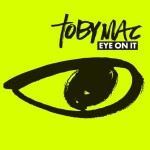 More experiments with low-end bass response and control took me to Toby Mac. His Eye On It album is quite compressed, but it also shows how well a pair of speakers can discern all of the elements in a dense mix. It’s a great test of how well you can make a very busy track still produce detail. On lesser speakers I’ve heard this track rendered as compete mush. On the KEF X300A’s it was well-imaged, with the computerized stereo synth voices throwing far into the room, and Toby’s vocals well-anchored in the center. Near the end of the track, the digital synth effects traveled quickly back and forth between left and right speakers and they cut a continuous path from right to left and back again that I hadn’t been able to hear before except with headphones. “Forgiveness”, which features renowned rapper LeCrae, let me hear the absolute finesse with which the aluminum tweeters can render an extremely complex track that bounces from soft solo break-outs back to thick—even distorted—sections where so much is going on you wonder how the drivers can even function effectively through it all. Yet the KEF’s did. The running score: KEF X300A’s 3, Mush: 0.
More experiments with low-end bass response and control took me to Toby Mac. His Eye On It album is quite compressed, but it also shows how well a pair of speakers can discern all of the elements in a dense mix. It’s a great test of how well you can make a very busy track still produce detail. On lesser speakers I’ve heard this track rendered as compete mush. On the KEF X300A’s it was well-imaged, with the computerized stereo synth voices throwing far into the room, and Toby’s vocals well-anchored in the center. Near the end of the track, the digital synth effects traveled quickly back and forth between left and right speakers and they cut a continuous path from right to left and back again that I hadn’t been able to hear before except with headphones. “Forgiveness”, which features renowned rapper LeCrae, let me hear the absolute finesse with which the aluminum tweeters can render an extremely complex track that bounces from soft solo break-outs back to thick—even distorted—sections where so much is going on you wonder how the drivers can even function effectively through it all. Yet the KEF’s did. The running score: KEF X300A’s 3, Mush: 0.
 After hearing enough complex and compressed music I wanted to expose myself to more open, airy tracks where I could focus on more of the delicate sound qualities of the system. For that I turned to Brandi Carlile. “The Story” had a nice gentle guitar sitting beheath her gently-reverberating vocals. In this track, the KEF X300A speakers completely disappeared. Brandi was front and center, on stage so-to-speak, even as the electric guitars kicked in and the dynamics of the track opened up to include greater instrumentation. The electric guitar solo panned towards the left speaker was represented perfectly in place—like I was listening to a live recording—and the break where Brandi’s voice comes back into focus really showed just how delicate the aluminum tweeters could be…right before her voice underwent some natural cracking which lacked any audible mechanical distortion or breakups in the accompanying sibilance. If none of this resonates, what I’m trying to convey is that there is a way in which the KEF X300A’s possess the admirable capability to feel very live, without losing any of that true detail and finesse that is required to “fool” the brain into thinking a performer is in the room (or on the stage as the case may be). These bookshelf speakers sound amazing in their lifelikeness and accuracy. I couldn’t get enough of them.
After hearing enough complex and compressed music I wanted to expose myself to more open, airy tracks where I could focus on more of the delicate sound qualities of the system. For that I turned to Brandi Carlile. “The Story” had a nice gentle guitar sitting beheath her gently-reverberating vocals. In this track, the KEF X300A speakers completely disappeared. Brandi was front and center, on stage so-to-speak, even as the electric guitars kicked in and the dynamics of the track opened up to include greater instrumentation. The electric guitar solo panned towards the left speaker was represented perfectly in place—like I was listening to a live recording—and the break where Brandi’s voice comes back into focus really showed just how delicate the aluminum tweeters could be…right before her voice underwent some natural cracking which lacked any audible mechanical distortion or breakups in the accompanying sibilance. If none of this resonates, what I’m trying to convey is that there is a way in which the KEF X300A’s possess the admirable capability to feel very live, without losing any of that true detail and finesse that is required to “fool” the brain into thinking a performer is in the room (or on the stage as the case may be). These bookshelf speakers sound amazing in their lifelikeness and accuracy. I couldn’t get enough of them.
 Next up was “Rainy Day Woman” from Kat Edmonson, a track that really takes you back and lets you sit back and forget yourself for a while. A good friend of mine describes this artists as “a throwback—almost as if Audrey Hepburn did a record.” It’s a fitting description, and Kat’s vocals remind me of being on set for an old black and white film. I say “on set” because the fidelity of those old tracks is often heinous, but Kat’s music is dynamic, full of wondrous detail, and backed by a well-mixed band. “You Said Enough” opens with Kat in an up-front, raw vocal, interspersed with a well-defined Lation-esque bass and percussion combo that is panned into a nice, wide soundstage. In “Oh My Love” the bass was really full and pleasing—more than punch, more than deep…it was a well-rounded sound that gave some real gravitas to the track.
Next up was “Rainy Day Woman” from Kat Edmonson, a track that really takes you back and lets you sit back and forget yourself for a while. A good friend of mine describes this artists as “a throwback—almost as if Audrey Hepburn did a record.” It’s a fitting description, and Kat’s vocals remind me of being on set for an old black and white film. I say “on set” because the fidelity of those old tracks is often heinous, but Kat’s music is dynamic, full of wondrous detail, and backed by a well-mixed band. “You Said Enough” opens with Kat in an up-front, raw vocal, interspersed with a well-defined Lation-esque bass and percussion combo that is panned into a nice, wide soundstage. In “Oh My Love” the bass was really full and pleasing—more than punch, more than deep…it was a well-rounded sound that gave some real gravitas to the track.
Conclusion
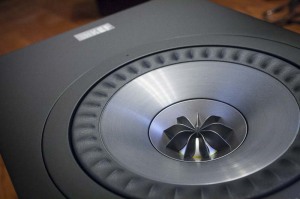 The KEF X300A speakers are clearly amazing. Authentic, transparent, detailed, rich…these are all words I’d use to describe them to a friend. The only question is whether they’re worth the $599 asking price. My answer is a simple, direct, “Yes.” Here’s why: You can easily spend $200-$300 on a pair of speakers that you still need to connect to an AV receiver or amplifier. And that amount of money is hardly considered a lot to spend on speakers. With the KEF X300A speakers it’s hard to argue with the fact that you get just about everything you need in a pair of computer speakers, stereo bookshelf speakers, or studio monitors…and you get it for relatively cheap. I’ve spent considerably more in my time for far less. Now that the street price for the X300A’s has dropped from the original $800, they’re almost a steal if you want quality. And, believe me, you do. In fact, if you don’t have the money to spend, don’t listen to these speakers—you’ll never be satisfied with anything less if you do.
The KEF X300A speakers are clearly amazing. Authentic, transparent, detailed, rich…these are all words I’d use to describe them to a friend. The only question is whether they’re worth the $599 asking price. My answer is a simple, direct, “Yes.” Here’s why: You can easily spend $200-$300 on a pair of speakers that you still need to connect to an AV receiver or amplifier. And that amount of money is hardly considered a lot to spend on speakers. With the KEF X300A speakers it’s hard to argue with the fact that you get just about everything you need in a pair of computer speakers, stereo bookshelf speakers, or studio monitors…and you get it for relatively cheap. I’ve spent considerably more in my time for far less. Now that the street price for the X300A’s has dropped from the original $800, they’re almost a steal if you want quality. And, believe me, you do. In fact, if you don’t have the money to spend, don’t listen to these speakers—you’ll never be satisfied with anything less if you do.
You can get away with spending less, but after hearing the KEF X300A powered speakers, I can’t imagine why you’d want to. At $599, these are quite possibly the very best powered speakers you can buy.
KEF X300A Speakers Specs
- System type: Two-way bass reflex
- Drivers: Uni-Q driver array
- Tweeter: 1in. vented aluminum dome
- Midrange: 5.25 in. magnesium/aluminum alloy
- Frequency response: 58Hz – 28kHz (+/- 3dB), 49Hz – 45kHz
- Peak SPL: 104dB
- Amplifier type: Twin Class AB
- Power: 50W LF, 20W HF
- AC power input: 100-120VAC, 50/60Hz
- Analogue input: 3.5mm stereo jack
- Digital input: Mini USB Type B (2.0)
- Audio format support: Up to 96 kHz/24-bit
- Controls: EQ switch, system volume
- Internal volume: 4.7L
- Finish: Gunmetal
- Dimensions: 11.0 x 7.1 x 8.5 in.
- Weight : 16.5lbs (7.5kg) ea

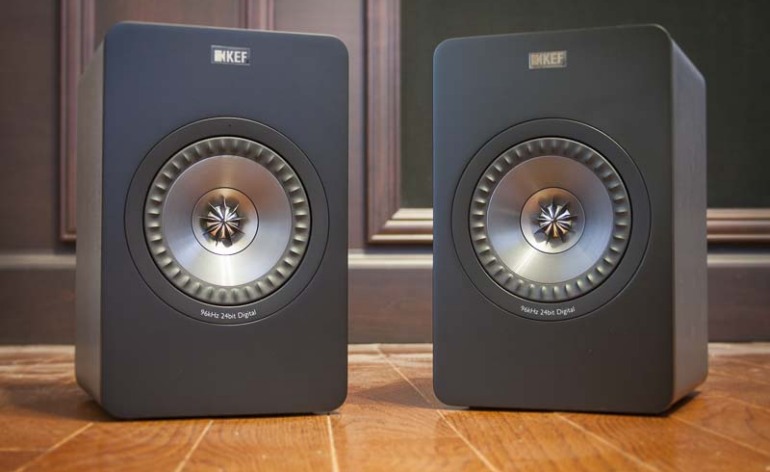
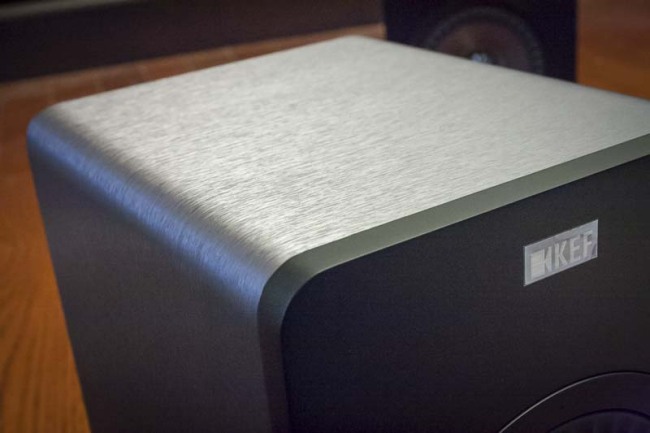
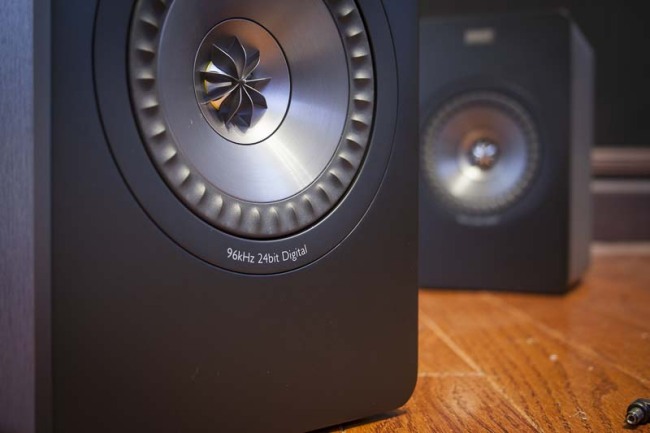
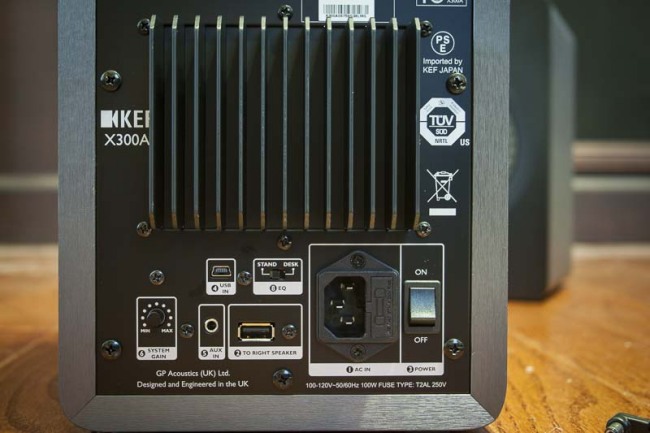

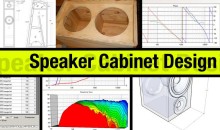
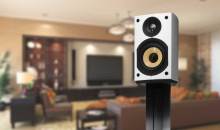
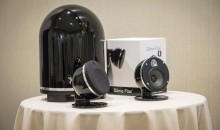

Dear Clint , thanks for the lovely review above . Iam very keen to purchase this speaker but had a query which I hope u sort it out was about the bass part of this unit , does it have as much base as the jbl onbeat xtream speaker dock?
Dear Clint, How can I connect my KEF x300A non wireless speakers with sony dn1070d AV receiver? I know you can connect with 3.5 mm jack but I would like to see best audio quality possible. The only connection is usb which receiver does not have that option for output.